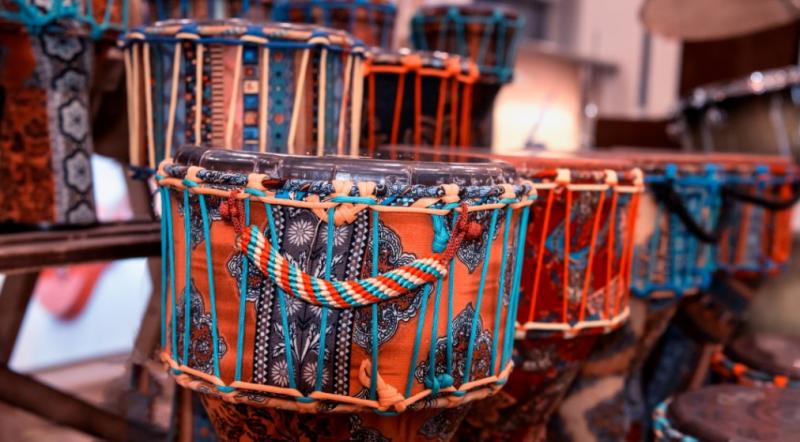
An Exploration of African Music & Culture
“The curious beauty of African music is that it uplifts even as it tells a sad tale. You may be poor, you may have only a ramshackle house, you may have lost your job, but that song gives you hope...” Nelson Mandela
Music has an incomparable ability to connect cultures and people like no other, and nowhere is this connection between people and music seen more so than in Africa. A vibrant and colourful continent, music is of great importance in African society and is used for a multitude of purposes from religious ceremonies to retelling tribal history in enthralling rituals. Much more than just entertainment, music is a way of life that has deep historical and cultural significance as it becomes a way of documenting the struggles that African people have endured over the centuries such as the tragic days of the Atlantic Slave Trade to the more recent time of apartheid politics. In many societies, music becomes a way of finding solidarity with your fellow countryman, of venting frustration and anguish, celebrating joyous occasions as well as challenging oppressive establishments in the most poetic and poignant ways.
African musical performance is a true spectacle to witness as people use instruments, their voices and bodies to create exciting rhythms that inspire all those around them. A fusion of diverse cultures, ethnic groups and spirited tribes has resulted in each African country boasting a profusion of eclectic music styles. While it would be impossible to go through every musical variety that exists – African music varies from village to village let alone country to country – we’ve delved deep into African musical idiom to give you an insight into some of its most prolific and exciting styles that will have you clapping your hands and stomping your feet.
Kenya
Music in Kenya celebrates the country’s ethnic and linguistic diversity and is based on more than 40 languages. When you envisage Kenya, images of the colourful Maasai tribe come to mind, an iconic emblem of the country. Avoiding the use of instruments, the music of the Maasai tribe is exemplified by the beautiful sounds of the voice and watching them perform is a truly remarkable sight to behold as the males stand in either a row or circle and begin song with a deep low grunting sound until the leader begins singing short phrases while the others famously jump up and down. While traditional Maasai music focuses on utilising the vocals, the guitar is the most important instrument in popular Kenyan music – particularly in the benga genre. Evolving in the late 1940s and 1960s, benga originated in Nairobi and its roots can be traced back to the Luo community by Lake Victoria who adapted traditional dance rhythms that can be heard in clubs today across the country.
Nigeria
There are an abundance of musical styles in Nigeria, ranging from folk song to contemporary music that is popular across the world. Afrobeat is perhaps the country’s greatest export; developed in the 1970s, afrobeat is an upbeat style that blends beautifully with American funk and jazz genres to create an infectious and up-tempo rhythm. Fela Kuti was the enigmatic pioneer of afrobeat, wanting to distinguish his work from American soul singers such as James Brown. In recent years the music has experienced a somewhat international revival, particularly within the UK with Nigerian singer D’banj and Ghanaian-British singer Fuse ODG incorporating afrobeat into their songs and both have enjoyed top 10 hits respectively. Traditional Nigerian music is typified by the call and response format where a lead singer and choir interchange verses and chorus, often accompanied with instruments. Many songs are considered workers’ songs as they are sung to the rhythmic pattern of manual work.
Ghana
Similar to Nigeria, Ghana is yet another West African nation where music is fundamental in society and has gained international renown for its funky rhythms that blends with contemporary music styles, creating dynamic sounds. Originating in the early 20th century, the most popular genre is undoubtedly highlife, which takes influences from Akan music and uses the jazzy sounds of horns and guitars to give an up-tempo rhythm that you just can’t help but tap your feet to. In the 1990s, Hiplife emerged as an exciting style, fusing Ghanaian culture with hip hop. As in many African countries, religion has an essential role in society and Ghana is no different with soulful gospel music setting the tone for church services. Furthermore, while in many western societies death is a mournful and solemn occasion, in Ghana it is a celebration of life with song and dance vibrantly accompanying the ceremony.
Angola
Angolan music is rooted in its origins as a lusophone community with many of its music and dance genres drawing parallels with Portuguese and Brazilian culture. Created by Angolan slaves, semba is part of the same family of Brazilian samba but with its own distinct voice that has a subject matter revolving around storytelling with cautionary tales and social events sung about in a wonderfully witty way. Gaining increasing international recognition and often offered at many dance schools, you may already be familiar with kizomba, an intimate dance that sees dancers intertwined as they move their body with the seductively slow rhythm of sensual songs typically sung in Portuguese. Another well-known Angolan genre with international stardom is kuduro, an energetic and carnival-esque beat that you can’t help but dance too with summer anthem Danza Kuduroby Puerto Rican singer Don Omar encapsulating the scintillating spirit of the genre.
South Africa
With a music tradition so incredibly rich and intrinsically linked with its colourful ethnic make-up it’s hard to know where to start with South Africa as the country’s music scene is characterised by an assortment of styles and artists who draw on a variety of influences, including the country’s past to emotionally document the struggles the nation has faced. After gospel music, maskandi is the second most popular genre and is particularly popular in urban cities such as Johannesburg and Cape Town as well as the sprawling KwaZulu-Natal province. The traditional folk music of the Zulu people, maskandi is the music of the ‘man on the move’. It is played using portable instruments and tells the story of the trials and tribulations, joys and ecstasy of the Zulu man. Jazz is also fundamental in South African society and in the rainbow nation’s cities you’ll find swathes of trendy jazz clubs showcasing talented artists in über cool settings.
Out of Africa
To talk about African music must inevitably involve discussing how the various music styles from across the continent have influenced music and artists all over the world, particularly in the United States where African diaspora communities and their music traditions have heavily shaped modern day genres. The music legacy of Africa in North America dates back to the days of the Atlantic Slave Trade and out of the hardships of slavery emerged the musical and lyrical beat we know as the Blues.
The 20th century in particular saw an explosion of African-American music and black artists on a worldwide scale with many energetic genres appearing such as rock & roll, doo wop and jazz to name but a few. In 1959, Berry Gordy created the Motown label, the first record label dedicated to featuring African-American artists, producing many crossover stars including Marvin Gaye and the Jackson 5. In more recent years, contemporary styles such as R&B, hip hop and house, have gained international fame. African music and tribal language interjections have also been used in cinema, from the songs in the Lion King featuring Zulu and Swahili words; hakuna matata, instantly springs to mind as the Swahili phrase literally means ‘no worries’ and is arguably the stand out, most uplifting track of the movie, and recent Hollywood blockbuster Black Panther also drew inspiration from authentic African music and culture, with traditional instruments such as the talking drum used in the official soundtrack.
Enchanting and inspiring, African music has a captivating ability to transcend borders in colourful explosions of song and dance that marvellously reflect the continent’s rich and diverse culture. Whether it is from attending a traditional church service in Ghana or listening to Beyoncé’s latest album, African music encompasses all stages of life, showcases all emotions and is a magnificent expression of life itself.
The Instruments behind the Music
Each genre is epitomised by a distinct musical instrument with drums and string instruments the most common varieties. Even though we can’t pick out everything, we’ve rounded up six of the most common African instruments that best represent the sensational sound of Africa.
Kora
The kora is a long, lute shaped instrument with 21 strings, made out of a calabash cut in half and covered with cow skin. It is so iconic that it has even had a music award ceremony named after it – The Kora Awards. Even though the shape of it is similar to guitar, the sound is more akin to a harp.
Shekere
As the onomatopoeic name of the instrument suggests, this is a shaker instrument that in addition to being used in music rituals in West Africa, it also illustrates the decorative and creativity of the tribes with colourful beads adorning the wooden instrument.
Kalimba Thumb Piano
The kalimba is an important percussion instrument often played at religious ceremonies, weddings and other social gatherings. It is more widely known in western culture as an African thumb piano as the musician will pluck the metal tines – which are staggered like piano keys – using their thumbs.
Djembe Drum
Often describes as being the sound of Africa, the djembe drum has been around since the 12th century and was traditionally played by story tellers – known as Griots – to accompany stories of cultural and historical significance.
Udu
In the Nigerian language of Igbo the word ‘ùdù’ actually means ‘vessel’ and this is exactly what this is: a watering jug except with a hole in it that when hit produces a bass sound. It is typically played by women during ceremonies.
Akoting
The modern-day banjo is believed to be based on this peculiar three-stringed instrument found in West Africa. The akoting belongs to the Jola people and has seen its composition change over the years from strings originally made of palm tree roots to them now made of nylon fishing line.
Share this article:



















